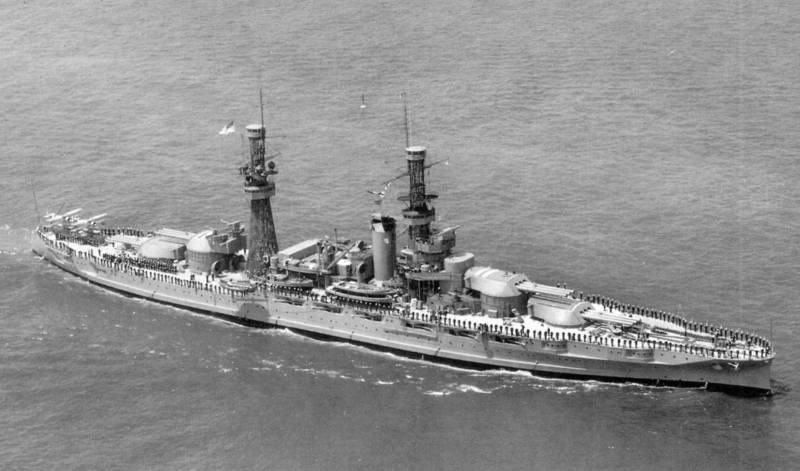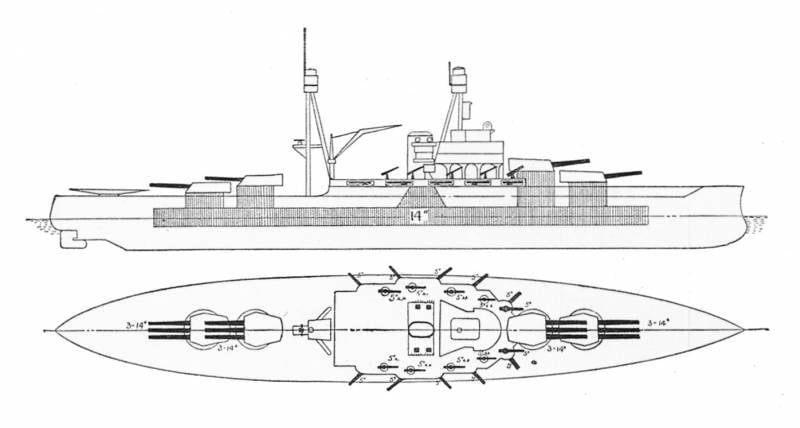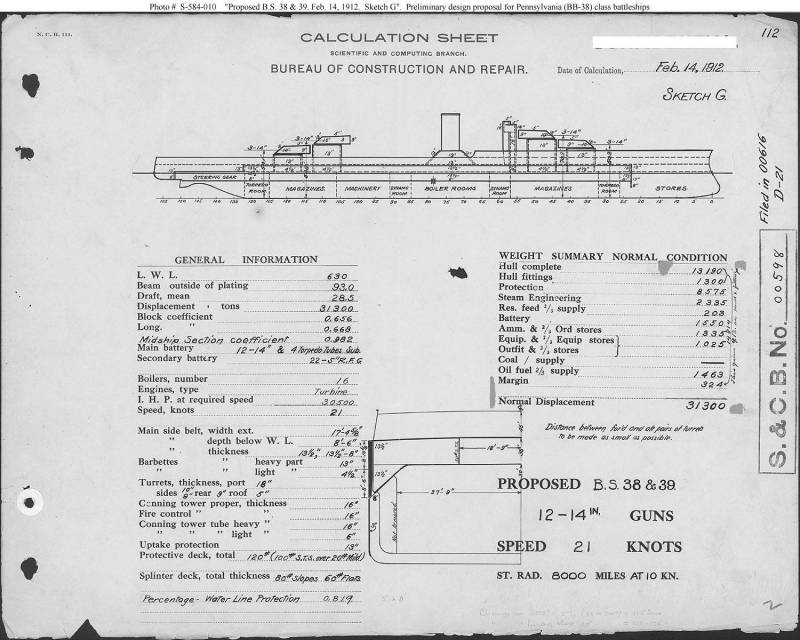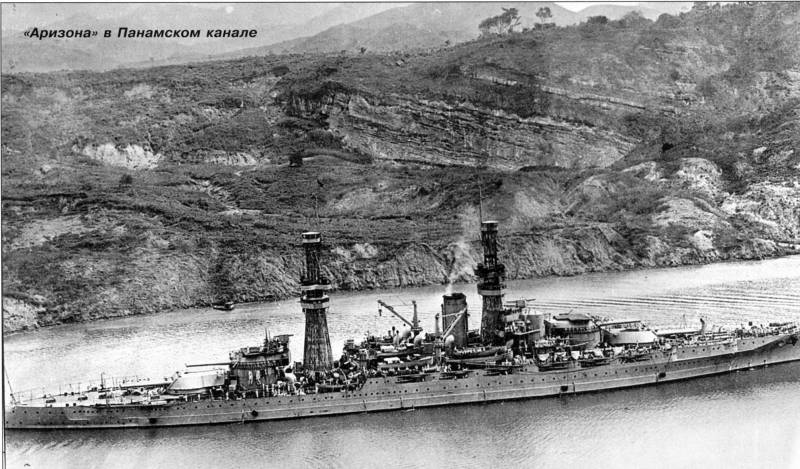"Standard" battleships of the USA, Germany and England. American "Pennsylvania". H. 3
Reservation
It would seem that it is a pleasure to describe the armor protection system of American standard battleships, because, unlike their European counterparts, it should be much simpler and more understandable. It is all the more strange that, perhaps, the author of this article has the most questions regarding the booking of Pennsylvania type battleships: available information is very contradictory.
Usually the following explanation explains the story of the American battleship reservation system. The US admirals saw Japan as their main adversary, building a very powerful linear fleet, with which the US Navy was to meet in the tropical regions of the Pacific Ocean, which are characterized by excellent visibility.
From here the American naval thought drew some fairly obvious conclusions. The battles will take place at distances that have been considered enormous to this day, and the enemy ships will be bombarded with a hail of high-explosive shells in the same way as the Japanese Imperial fleet in Tsushima did not succeed: no fire control system can provide the required number of hits. If so, preference should be given to armor-piercing shells of heavy weapons, capable, with a successful hit, to cause decisive damage to an armored target. The Americans believed that the Japanese saw the situation in the same way as they did, and “Pacific Armageddon” would be reduced to a battle of battleships that showered each other with armor-piercing projectiles from a distance of 8-9 for miles, or maybe more. For protection in such a battle, the “all or nothing” booking scheme was best suited to protect the machines, boilers and main-caliber guns with the strongest armor possible. All the rest was worth not booking at all so that the ship would have a good chance to “pass through” the enemy shell without detonating it. Indeed, a relatively “tight” fuse of an armor-piercing projectile could not be bobbed if the latter, passing from side to side, did not meet an armored plate in his way, broke through only a few steel bulkheads.
Accordingly, in the perception of many, the armor protection of American battleships looks like such a rectangular box of powerful armor plates, covered on top with thick armored decking, and leaving the tip unarmored.
But in reality this is not so: if only because the defense of the hull of the battleships of the type “Oklahoma” and “Pennsylvania” consisted not of one box, but of two. But first things first.
The basis of the protection of the Pennsylvania type of battleships was a very large length of the citadel. According to A.V. Mandel and V.V. The length of the main armor of the “Pennsylvania” was 125 m. 130,46-th tower. It is worth noting one important feature of American battleships: their creators considered it necessary to protect not only cars, boilers and powder cellars of main-caliber guns with a citadel (as we already know, Americans kept the main supply of projectiles in barbats and towers), but also underwater torpedo tubes. On battleships of the type “Oklahoma”, the project 24 of the traverse torpedo tubes was provided for, they were placed immediately in front of the barbat of the 4 tower of the main caliber and after the barbat of the 4 tower, adjoining them closely. That is why the “Oklahoma” citadel and “dropped in” behind the barbettes of these towers in the stern and bow. As for the Pennsylvania type of battleships, on these ships it was decided to abandon the stern pair of torpedo tubes, leaving only the bow, but did not shorten the citadel.
It must be said that the citadel of the American battleships was very long: given that the length of the “Pennsylvania” at the waterline was 182,9 m, the main armor belt defended 71,3% (68,3%, if relative to the length of the armor belt AV Mandel and VV Skoptsov were right) the length of the ship!
In addition to outstanding length, the armor belt of the “Pennsylvania” type battleships also had a considerable height: it consisted of a single row of armor plates with a height of 5 337 mm. The thickness from the top edge, and over the 3 359 mm downward was 343 mm, and over the following 1 978 mm evenly decreased from 343 to 203 mm. The armor plates were located "cut" to the ship's casing, so from the outside throughout all 5 337 mm, the battleship's armor looked monolithic and smooth. The upper edge of the armor plates was at the level of the second deck, and the lower one fell below the third.
In the normal displacement of the battleship, his armored belt towered above the water on 2 647 mm. Thus, from the constructive waterline down over the 712 mm, the armor belt kept the thickness of 343 mm, and then, over the length of 1, 978 mm gradually got thinner to 203 mm, and the board protected everything under water on 2 690 mm. In other words, the Americans positioned the armor belt so that it protects the board approximately 2,65 m above and below the waterline. It should be noted that there was a slight difference on the “Arizona”: Americans usually laid armor plates on a teak lining, and also arrived at “Pennsylvania”, but for the “Arizona” they used cement for the same purpose.
Unfortunately, the armor belt within the citadel is hardly the only part of the armor protection of the body of the battleships of the type "Pennsylvania", the description of which almost completely coincides in all sources. But about the rest of the discrepancies, and, very often, very significant.
Analyzing and comparing data from various sources on “Oklahoma” and “Pennsylvania” type battleships, the author of this article came to the conclusion that, most likely, the most accurate description of the battleship reservation system was given by V. Chausov in his monograph “Pearl Harbor Victims - Battleships "Oklahoma", "Nevada", "Arizona" and "Pennsylvania", especially since this book was written later than the others: for example, the work of A.V. Mandel and V.V. Skoptsova was published in 2004 g., V. Chausova - in 2012 g. Accordingly, in the future we will give a description of booking of battleships of the “Pennsylvania” type according to V. Chausov, and we will note discrepancies only in cases where the latter are of extremely essential nature.
Throughout the citadel’s armor belt, the main armored deck rested on its upper edge, as if covering the top of the hull with a cover from above. The main armored deck was at the level of (and was) the second deck of the battleship, but the data on its thickness vary considerably.
The canonical version is considered to be that it consisted of two layers of STS armor steel with a thickness of 38,1 mm each (76,2 mm in total), laid on the 12,7 mm substrate of ordinary shipbuilding steel. Formally, this makes it possible to consider the thickness of the main armored decks of battleships of the “Pennsylvania” type 88,9 mm, but still it should be understood that its actual armor resistance was still lower, since the “three-layer cake” contained the inclusion of regular, non-bronze steel, and two layers of 38,1 mm armor plates were not equivalent to monolithic armor.
However, according to V. Chausov, the main armored type of battleships of the Pennsylvania type was noticeably thinner, because each layer of STS steel had a thickness of not 38,1 mm, but only 31,1 mm, and the steel substrate was also thinner - not 12,7, but only 12,5 mm. Accordingly, the total thickness of the upper deck of the battleship was not 88,9 mm, but only 74,7 mm, moreover, everything we said above about its armor resistance, naturally, remains in force.
One deck was located below the main armored deck (in this case, it was approximately 2,3 m) and there was a third deck, which had bevels connected to the lower edge of the armor belt. Within the citadel, it had anti-fragmentation booking, but, again, the data on it diverge. According to the classic version, it consisted of 12,7 mm shipbuilding steel, on which in the horizontal part 25,4 mm armor plates were laid, and on the bevels - 38,1 mm. Thus, the total thickness of the anti-splinter deck in the horizontal part was 38,1 mm, and on the bevels - 50,8 mm. But, according to V. Chausov, its thickness was 37,4 mm in the horizontal part (24,9 mm STS and 12,5 mm shipbuilding steel) and 49,8 mm on bevels (37,3 mm STS and 12,5 mm shipbuilding steel).
Nose traverse consisted of three rows of armor plates. In height, it started from the second deck, that is, its upper edge was flush with the upper edges of the armor plates, but the lower edge fell about 2 meters below the armored belt. Thus, the total height of the nasal beam reached 7,1 - 7,3 m or so. The first and second tier were armor plates 330 mm thickness, the third - only 203 mm. Thus, to the waterline and, approximately, on 2,2 m below it, the beam has a thickness of 330 mm, and below - 203 mm.
But aft traverse was significantly shorter and reached only the third deck, having a little more than 2,3 m height. The fact is that, outside the citadel, the third deck of the battleship “lost” bevels and was strictly horizontal - well, so the traverse extended to it.
However, one should not think that there was some kind of “window” in the protection of the battleship. Not at all - directly to the "box" of the citadel in the stern of the ship adjoined the second "box", designed to ensure the protection of the steering of the ship.
It looked like this. From the main armored belt to the stern, another armored belt stretched for about 22 m. Its main differences from the citadel's armored belt were smaller, by about 2,3 m, height - while the upper edge of the citadel's armor plates was at the level of the 2-th deck, continuing into the stern of the armor-belts only to the horizontal section of the 3-s deck. Thus, this armored belt adjoining the citadel protruded just 0,31 meters above the waterline, but its lower edge was at the level of the citadel's armor plates.
The height of this armored belt was about 3 m, while for the first meter (to be exact 1 022 mm) its thickness was 330 mm, and then, at the same level where the “fracture” of the main 343 mm belt began, the thickness of the second armored belt gradually decreased from 330 mm to 203 mm. Thus, on the lower edge both of them, and the citadel's armor belt, and the second stern armor belt, had 203 mm, and, as we said, this edge was at the same level in both belts.
This armor belt, which covered the steering, was closed from the stern by another traverse, which consisted of absolutely the same slabs as the armor belt itself - they also had about 3 m height, also had about 330 mm thickness for about one meter, and then gradually thinned to 203 mm and located on the same level. On the upper edge of the 330-mm belts and the beam there was a third deck, which here (unlike the citadel) had no bevels. But she was very heavily armored: 112 mm armor steel STS on the 43,6 mm "substrate" of conventional shipbuilding steel gave a total of 155,6 mm protection.
It must be said that A.V. Mandel and V.V. Skoptsova claims that the third armor deck had bevels in the stern and was better protected than within the citadel, and the above horizontal protection was “added” to it additionally: but, apparently, this is an error that is not confirmed by any of the authors. This article of the protection schemes for battleships of the "Pennsylvania" type. Including those given by A.V. Mandel and V.V. Skoptsova.
In addition to the sides and decks, the hull of the Pennsylvania-type battleships had a very powerful chimney protection. On linear ships of this type there was one pipe and chimneys to it from the main armor to the deck of the forecastle, that is, for two interdeck spaces (over 4,5 m) were protected by an oval casing 330 mm thick. On the second ship of the series, “Arizona”, the casing design was replaced - it had a variable thickness from 229 mm in the center plane of the ship, where the casing was covered as much as possible by other hull structures and barbets of the main caliber towers, which made it unlikely to hit 305 mm closer to traverse and even 381 mm directly on the stretch parallel to the board of the ship. Below the main armored hull, between it and the splinter deck, chimneys on four sides were covered with armor plates 31,1 mm thick.
We have already described defense of artillery before, but we will repeat it so that a respected reader does not have to search for data on various articles. The towers of the main caliber had a very powerful defense. The thickness of the frontal plate was 457 mm, the side plates closer to the frontal plate - 254 mm, then - 229 mm, the feed plate - 229 mm. The roof was protected by 127 mm armor, the floor of the tower was 50,8 mm. The barbety had 330 mm along the entire length up to the main armored deck, and between it and the fragmentation, where the sides defended 343 mm armor - 114 mm, below the fragmentation barbety were not booked. Mine caliber armor did not have.
The conning tower had a base of STS armor steel with a thickness of 31,1 mm, on top of which 406 mm armor plates were installed, that is, the total thickness of the walls reached 437,1 mm. The roof of the conning tower was covered with two layers of body protection with a thickness of 102 mm each, that is, 204 mm of sheath thickness, and the floor is 76,2 mm. Interestingly, the "Pennsylvania", which was built as a flagship, the conning tower was a two-tier, and the "Arizona" - a single-tier.
A communication pipe with a diameter of one and a half meters went from the conning tower down to the main armored deck. The thickness of its armor was 406 mm, from the main one to the fragmentation deck - 152 mm.
A detailed comparison of the armor protection of the “Pennsylvania” type battleships with European battleships will be made later, but for now let us note two vulnerabilities of American ships: one obvious, and the second not.
The obvious vulnerability lies in the vicious idea of storing projectiles in barbetas and turret battleships. Like it or not, but only the frontal plate of the tower had an ultimatum-powerful defense - 457 mm of armor really was almost impossible to master at reasonable combat distances. But the side walls of the towers with their 229-254 mm, and 330 mm of barbet did not provide such protection, and they could easily miss the enemy armor-piercing projectile, even in its entirety. It was fraught with the detonation of more than two hundred projectiles placed directly in the turret and on the 330 mm barbet's “shell layer”.
Unobvious vulnerability. We did not mention the 127 mm roof of the towers of "Pennsylvania" and "Arizona", but it also could not protect the installation of the main caliber from an impact 381-mm projectile. The British themselves, installing a similar thickness of protection on the roofs of the towers "Hud", had some doubts about its sufficiency. And because they have made the appropriate tests of the latest "greenboy". Two 343-mm projectile 127 mm did not pierce the armor, but the 381-mm armor-piercing projectile “passed” the tower’s roof without any problems, leaving an even hole with edges bent inwards. According to the test results, it was decided that Admiral Beatty (with doubts of whom this story) was absolutely right, recommending to bring the thickness of the roof of the towers to 152 mm. Since orders had already been placed on the Hud tower, and they were in the process of manufacturing, it was decided not to change anything on them, but to provide the 152 mm with the roof of the tower of three production ships that were supposed to be built after him, but as you know, “Hood »Became the sole representative of the series.
But the fact is that the English towers for Hud, in contrast to the installations of the previous types, had an almost horizontal roof, it only had a slight inclination to the side walls. And if the British 381-mm projectile overcame it without problems ... it would have struck the main armored deck of the battleships of the type "Oklahoma" or "Pennsylvania" without any difficulties.
In other words, usually American battleships are perceived as ships with a very strongly protected citadel, which, among other things, had a great superiority over the battleships of other countries in horizontal defense. But in practice, the armor deck is at least 74,7 mm thick (to which, after Chausov, the author of this article is inclined), although the canonical 88,9 mm, and even non-uniform, and even the usual steel layer did not represent any serious protection against hitting heavy shells caliber 380-381 mm. And after its penetration, the enemy shell would be separated from the engine, boiler rooms, cellars with gunpowder supplies and torpedoes, just an inch armor on a half-inch steel backing, which was not enough even to protect against a shell splinter.
Anti-torpedo protection
It was quite peculiar and unlike the PTZ schemes used on the battleships of other countries. "Pennsylvania" and "Arizona" had a double bottom, reaching to the lower edge of the armor belt. Behind him were empty compartments throughout the citadel, which ended in a very powerful anti-torpedo bulkhead, consisting of two layers of STS armor steel for 37,35 mm each, that is, the total thickness of the bulkhead was 74,7 mm! This bonperesembly with its upper edge reached the bevel of the lower armored deck, and the lower - the second bottom. Behind it was still empty space, and, finally, the last, filtration bulkhead, 6,8 mm thick. According to the logic of the creators, the torpedo that hit the ship spent energy on breaking the outer skin and double bottom, then the gases freely expanded in empty space, significantly losing their penetrating ability, and the fragments and residual energy of the explosion were delayed by the main protection, which was represented by a thick armored bulkhead PTZ. If it turned out to be partially damaged and there was a leak, then its consequences should have been localized by the filtration partition.
Interestingly, the empty spaces of the PTZ, the total width of which was 3,58 m, should not have been filled with anything. The water and fuel storages were located directly on the second floor inside the space protected by the PTZ, and thus, in fact, the machines, boilers and cellars below protected not even a double, but a triple bottom, the “third echelon” of which was exactly the above compartments.
It should also be mentioned that the battleship was divided into 23 watertight compartments, with the watertight bulkheads reaching the armored deck, but it is not clear which one. Most likely, we are still talking about a fragmentation deck.
Power plant
It represented a big step forward compared to the battleships of the previous series. The Nevada-type battleships were twin-shaft, and the Americans managed to build a steam engine instead of turbines on the Oklahoma. On the ships of the type "Pennsylvania", finally, the final transition to the turbines occurred, in addition, both battleships of this type had a four-shaft power plant.
Nevertheless, the desire to put different power plants on ships of the same series was still maintained by the Americans. The boilers on the Pennsylvania and Arizona were identical: each battleship was equipped with 12 Babcock & Wilcox oil boilers, but at the same time, Curtis turbines were installed on Pennsylvania, and Parsons on Arizona. The latter included, in addition to a set of high-pressure turbines for rotating internal shafts and low-external ones, also cruising turbines, thanks to which it was supposed to achieve a fair gain in range. Alas, these hopes were not justified, since the effect turned out to be much lower than planned, and these turbines (Parsons) themselves turned out to be unsuccessful, and perhaps the most unsuccessful in the American navy, since the units turned out to be very capricious and unreliable.
According to the project, Pennsylvania-type battleships were supposed to develop an 21 node with the power of 31 500 hp mechanisms, which was supposed to ensure the speed of the 21 node (unfortunately, it is unclear whether this is a natural or forced thrust). On the tests of "Pennsylvania", contract power was not achieved, and it was only 29 366 hp, but the speed, nevertheless, was 21,05 knots. Subsequently, during the operation, both battleships easily reached the 31 500 HP, put on the 34 passport. and even surpassed them: so, the maximum recorded power of the power plant "Arizona" was 000 21 hp Of course, this was unlikely to greatly increase the travel speed over XNUMX knots. The contours of the Pennsylvania-type battleships were distinguished by high completeness, were apparently optimized for the speed indicated above, and therefore required a large increase in power for its growth.
A normal supply of oil was 1 547 T., full - 2 322 T. It was assumed that the full supply of the battleships could pass 8 000 miles 10-nodal speed. In reality, Pennsylvania could accept 2 305 t, and, based on calculations based on actual fuel consumption, the battleship was able to go 6 070 miles on 12 nodes (for some reason, the calculation for the speed of 10 nodes is not given). As for the "Arizona", when using cruising turbines on 10 nodes, it was able to go only 6 950 miles, and in general it can be said that the Pennsylvania battleships were somewhat under-range.
It is noteworthy that the Americans went the furthest along the path of "oiling" their fleet. The Germans continued to consider coal as the main fuel, the British - as a backup, but only in the United States refused it altogether. However, it should be understood the conditions in which this was done. The benefits of oil heating boilers understood everything. But Germany did not have oil deposits on its territory, and could not expect to replenish its reserves in the event of a war with England and the announcement of a blockade. England, although it could count on the delivery of oil by sea, still, like Germany, did not have oil fields in the metropolis and in the event of any force majeure risked immobilizing its fleet. And only the United States had enough deposits to absolutely not be afraid of the depletion of oil reserves - and therefore did not risk anything at all, transferring the fleet to oil heating.
This concludes the description of the Pennsylvania type of battleships. Ahead the most interesting is a comparison of the three “champions” we have chosen among the “standard” battleships of England, Germany and America.
To be continued ...




Information